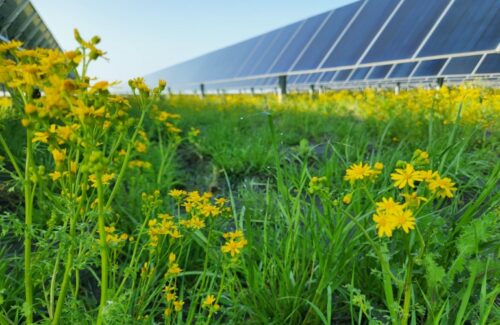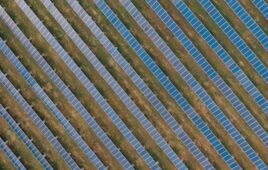According to the latest data from the U.S. Energy Information Administration (EIA), renewable energy sources provided almost 23% of the nation’s electrical generation in the first nine months of 2022.
Renewable energy sources (including residential solar) increased their electrical output by 15.44% compared to the same period a year earlier. Year-to-date, renewables have provided 22.66% of total U.S. electrical generation compared to 20.33% in the first nine months of 2021.
For the nine-month period, electrical generation by wind increased by 18.64% and provided 9.75% of total electrical generation. Meanwhile, solar sources grew by 25.68% and provided 5.01% of the nation’s electrical output. In addition, generation by hydropower increased 7.98% and accounted for 6.29% of the total. Geothermal also grew by 6.95% while electrical generation attributed to the combination of wood and other biomass dropped by 1.12%.
Taken together, during the first three-quarters of 2022, renewable energy sources comfortably out-produced both coal and nuclear power by 15.52% and 28.25%, respectively. In fact, over the past half-decade, the mix of renewables has moved from fourth into second place among electrical generating sources while relegating coal and nuclear to third and fourth place, according to the SUN DAY Campaign.
However, EIA’s data also suggest that renewable energy’s strong growth this year may slow down during the last third of 2022.
In September alone, electrical generation by solar grew by 21.02% and geothermal increased by 5.1% compared to September 2021. On the other hand, generation by wind dropped by 6.81% as did that by hydropower (down 1.14%) and biomass/wood (down 4.57%). Taken together, electrical output by renewables was just 1.45% higher than one year ago, and because electrical generation by all sources increased, renewables’ share in September was nearly unchanged from one year earlier (19.18% vs. 19.14%).
“For some time now, EIA has been forecasting renewables to provide 22% of U.S. electrical generation in 2022 — up from 20% a year earlier,” noted the SUN DAY Campaign’s executive director Ken Bossong. “While they presently are ahead of that level, a slowdown in generation by wind and hydropower during the last quarter of this year could result in renewables falling short of that mark while still exceeding their 2021 record output.”
News item from SUN DAY






Solar, Wind, and Geothermal. Fossil fuels are still necessary and these technologies may be advancing but they are in their infancy. Above all, the numbers in this report while interesting are not going to change minds about the lack of power density in an electric car. This means that at best, a hybrid is a stopgap solution and not an all electric.
If only people understood patience. It will take time for development and yes, there is great innovation! But…there is no patience–pushing technology that is great step toward less environmental impact is a goal though it can’t happen overnight. Just who is ready to recycle all those old solar panels (yes, it might be done)? How far are we from solving the lack of infrastructure to support charging? How about the fact that there is no solution yet to power density and that gasoline still is needed to power cars? Why make a goofy law to mandate electric or alternative fuel vehicles in California? Why does no one pay attention to the problems and act like they drank the cool aide? I will stop here…but there is so much more …
Solar energy is well past its infancy and is a proven and mature Tecnology
I was part of the group that enabled Southern California Edison build a huge concentrated
solar power plant in the 1980s.
And the largest public utility in the country, the LosAngeles Department of Water and Power has a 20 year fixed price contract for solar power. I don’t think they would have ever been irresponsible in planning, designing and constructing that project.
Technology and operations allow efficiencies to be gleaned from where and how the technology is used. IF Kelly Pickerel Energy (KPE) constructs a major 500MWp solar PV farm in a desert location, the site will have to also entrane a transmission line to bring the generated product to market. First at the solar PV farm the solar strings of D.C. buss will have to be inverted (converted) to A.C., at this time loses 2% of the power in conversion and this energy will have to be stepped up to high voltage with a 3% power loss per transformer step. This energy flows through the transmission line and loses maybe 0.5% of the power through line losses. When it hits a city or town along the way the voltage is stepped down at least two to perhaps four times to feed the end users. another 6% to 12% power loss. The reality is in the U.S. it is easy to lose about 18% of the generated power end to end. In rural areas, this may be 20% to 25% energy loss end to end.
Now (KPE) supplies the residential and small business sector. When (KPE) installs 500MWp on the roofs of 235,000 home and small business roofs, this allows about 9 to 10KWp solar PV on each roof, installing 30kWh of smart ESS at each site to store overgeneration and time shift this energy would allow on average a full 8 to 14 hours of solar PV power each day. With a 2% inverter efficiency loss, a round trip loss of 4% on the smart ESS, one would have a system on their roof that would use non-commodity energy for half the day almost every day. Compare the efficiency of 6% round trip loss compared to 12% up to 25% power loss. Installing the generation and energy storage where the energy will be used is more efficient than the old centralized generation with dispatch over transmission power lines with step up and step down transformer losses along the way. Cut out the middleman in energy costs and save yourself some money with a (KPE) home or small business solar + storage system.